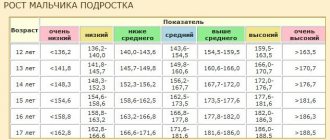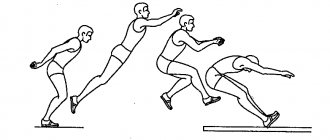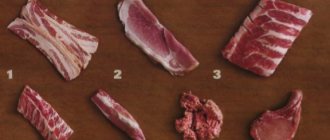Today we will touch on a topic that is sore for many beginners, and not only beginners. This is the theme of thin branches , that is, your thin hands. So, the topic is painful, but very important - men have very thin and thin hands.
If you don’t have pumped up arms, then consider that you are living in vain . I have not yet seen a single film where some handsome guy spectacularly climbed out of the pool, while his bicep the size of a starving mouse would be shown on the entire screen and a drop of water would flow down it in slow motion and all the girls around would faint at sight of this eighth wonder of the world.
If you want to captivate the public, you need to have big hands. I’ll tell you below how to pump up thin arms.
Thin bone and body type
Bone thickness is an important parameter for determining a person’s somatotype - his bodily structure, or body type. According to McRobert [1], a wrist circumference of 17.5 cm or less indicates an ectomorphic somatotype. However, it is worth noting that it is not entirely correct to judge your body type based on one single sign. In fact, body type is determined not only by the thickness, but also by the length of the bones. Moreover, the body classification is based not only on the characteristics of the skeletal system, but also on other body systems (the main ones are taken into account in our ectomorph calculator).
If we judge the type of person only by the bones, then it must be said that it is necessary to study not only the thickness of the wrist, but also the thickness of the ankle. In a true ectomorph, the thickness of the wrist and ankle will be proportional. If a person has thin arm bones (assessed by the wrist), but the bones of the legs (assessed by the ankle) are not thin, then it is wrong to talk about an ectomorphic body type. By the way, about the thickness of the ankle: a girth of 22.5 cm and below indicates a thin bone [2]. Moreover, if the difference between the thickness of the wrist and ankle is 5 cm, then we can say that the thickness of the bones of the arms and legs is proportional.
Until what age do bones grow in length and width?
Human bones, like other body systems, undergo certain changes throughout life. Almost all of them go through 3 stages in their development:
- Membranous.
- Cartilaginous.
- Bone.
The only exceptions are the integumentary bones - the face, cranial vault and collarbone. Cartilage appears during intrauterine development in the form of the rudiments of future bones, which are gradually replaced by bone tissue from the 8th week. After birth and until the end of growth, bone tissue goes through the following stages in its development:
- Slow growth is observed in the first year of life. The diameter of the diaphysis and bone marrow canal in tubular bones increases significantly, but their thickness remains virtually unchanged.
- In the period from 1 to 7 years, growth accelerates in length due to the epiphyseal cartilage, and in width due to the bone-forming function of the periosteum.
- The period from 7 to 11 years is a slowdown in growth.
- After 11 years, a phase of active growth begins and the formation of bone processes (apophyses), as well as the acquisition of final forms by the bone marrow cavities.
- Until the age of 18, the diameter and thickness of the walls of the diaphysis noticeably thicken. The processes are much more intense than before the age of 12. Young bones have a large vascular network, due to which intensive deposition of minerals occurs in them.
- The period ending at 16-24 years, during which the epiphyseal (cartilaginous) plate is replaced by bone and growth in length stops.
- The period is 18-40 years, during which the diaphyseal parameters stabilize and the processes of bone formation come into balance with the processes of destruction.
The main growth of bones in length and width ceases between 18 and 26 years of age with the completion of skeletal formation, although bone replacement continues throughout life. At the same time, its restructuring can continue to occur under the influence of external factors in the form of physical activity, as a result of which the bones become more massive, become thicker and stronger, and bone protrusions form near the tendon attachment points.
Thin bone and muscle growth
Let's return to the “folk wisdom” mentioned above: “a thin bone will not grow much meat.” Is the thickness of the bones the reason why muscles don't grow? No. Bone thickness is just an indicator of how physically powerful (strong) your body is. And if he is not like that (physically powerful, strong), then he grows poorly - this applies to both the thickness of the bones and the thickness of the muscles. There are, however, exceptions when there is good muscle mass on thin bones.
The power of the body depends on health and genetics, which, in principle, are interconnected.
Health is not only immunity, but also the general condition (functionality) of the body, that is, its performance. For example, lethargy, frailty, physical inactivity are things that are associated with poor health. The initial (primary) point in determining the level of health is the assessment of the cardiac system. Check with a cardiologist the functioning of your cardiovascular system in a state of calm and physical activity (more details). If there are certain violations or deviations from the norm, then consider that you will constantly have problems with muscle growth.
In turn, genetic power is either heredity (the genes of your parents) or the result of your own genes. Genes act on us through intermediaries, the main of which are hormones. Therefore, the genetic power of the body is controlled by the hormonal state. It is the activity of hormones that affects the growth of bone, muscle, and even fat tissue. Thin bone is most often evidence of insufficient secretion of sex hormones (insufficient specifically for physical strength (power); from the point of view of ordinary life, the level of hormones is, as a rule, quite normal).
Oddly enough, in this regard, you can fight genetics. After all, to increase the amount of sex hormones in the body, it is enough to train correctly. We have written more than once about the effect of training on the stimulation of sex hormones (testosterone). However, once again we emphasize the fundamental thing: it is strength training that stimulates the secretion of testosterone and retains it best.
Hormonal levels are not everything for bone growth in breadth. Bone thickening (meaning normal, healthy, not pathological, such as osteosclerosis) is:
mechanical load + sufficient hormonal background + normal bone metabolism.
By the way, it is strength-style training that allows you to create the mechanical load that most stimulates the compaction (strengthening) of bones. As for metabolism in bone tissue, it is important to know the following: vital elements for the normal functioning of bones are calcium, phosphorus and vitamin D. Of course, other micro- and macroelements also play a significant role.
What causes bone loss?
The following causes the launch of a pathological process in the body:
- Addiction to tobacco products. Smoking abuse leads to systematic destruction of bone structure. A sexually mature person who inhales tobacco smoke every day is at greater risk of getting a fracture than a person who does not have a bad habit. According to the results of special studies, even passive smokers are at risk.
- Drinking a lot of caffeine. The entry of a significant amount of tonic into the body interferes with the normal absorption of calcium by body tissues. To avoid harming your own health, researchers do not recommend drinking more than two cups of coffee per day.
- Development of alcohol dependence. Regular drinking of alcohol causes bone loss. The acceptable limit is one glass of wine or beer over several days.
Leading a sedentary lifestyle has the most negative impact on the condition of the skeleton. The statement is a fact proven by numerous studies and medical observations. Doing physical work, all kinds of exercises, morning exercises, on the contrary, help strengthen bone structures.
How to build bone mass through exercise? Doctors recommend doing physical activity at least 30 minutes a day. Among the most effective workouts that strengthen the skeleton are:
- Walking.
- Jogging.
- Going up and down stairs.
- Dancing class.
- Biking, roller skating, skiing, skating.
- Performing jumping rope.
We suggest you read How to lose weight if you have heavy bones
Professional trainers advise resorting to strength training. It's about lifting weights, using machines that provide resistance. Various parts of the body should be worked out qualitatively: legs, arms and shoulders, back, chest. However, it is not at all necessary to use all muscle groups in training every day. It is enough to alternate workouts.
Thickness vs. bone length
If bone thickness is an indirect sign of predisposition to bodybuilding (associated rather with the general physical development of a person), then bone length is a parameter that can be directly related to the characteristics of muscle growth. The fact is that muscle growth on bones of different lengths can be carried out in different ways.
Thus, a typical picture for short bones: the body of the muscle (abdomen, i.e. its main mass) sharpens at the ends of the bone, turning into the so-called muscle tails, which attach the muscle to the bone; the muscle tails are also pulled together by tendons.
A typical picture for long bones: the muscle body (abdomen) begins to sharpen relatively far from the ends of the bone and passes into muscle tails, then (towards the ends) the muscle tails pass into tendons, with the help of which the muscle group is attached to the bone. It turns out that the bulk of the muscle is not concentrated along the entire length of the bone, if the bone is long. That is, there is no more meat on long bones than on short ones. But to increase meat on long bones, muscle growth must be significantly greater, which significantly lengthens the time required to solve the problem.
Patterns of bone formation
The principles of bone tissue formation were formed by P.F. Lesgaft - the founder of functional anatomy, which are as follows:
- Bone tissue is formed in places of maximum tension or compression.
- The degree of bone development depends on the activity of the muscles associated with it. Its external shape changes under the influence of pressure or stretching, that is, development is more intense where there is higher motor activity. In places where muscles are attached to the bone, an outgrowth is formed with the help of tendons, and when woven into the periosteum in a wide layer, a depression is formed.
- The tubular and arched structure of the bone determines its strength and low weight with the least amount of bone material required.
- The external shape of bones is formed depending on the pressure exerted on it. Their shape and position are influenced by internal organs, and even vessels, where grooves form on the bones.
Results
1. If you are truly an ectomorph, then your bone thickness is a result of the rate of metabolic reactions in your body. It (this speed), as a rule, interferes with the normal gain of muscle mass. We call this part of ectomorphs hardgainers (ectomorphic hardgainers). At the same time, according to observations, for a certain part of ectomorphs, growing muscles is not a problem.
2. If you are not an ectomorph, but you have thin bones and do not gain mass well, then:
(a) you do not have enough physical strength (health) for muscle hypertrophy; You most likely have a hard time with physical activity and take a long time to recover from it. Perhaps your health is not all right or you have low physical potential from birth (usually in such cases, in contrast, nature rewards you with high intellectual potential). Either way, you are a hard gainer.
(b) you have bad genetics for bodybuilding. This may be due to a “bad” type of muscle fiber, a deficiency of some hormones (for example, testosterone) or an excess of others (for example, estrogen), or some ectomorph traits passed on from mom or dad. In other words, you are also a hard gainer.
Restoring calcium
Calcium is the basis of bone tissue.
There is a generally accepted calcium intake of about 1 gram. per day. For teenagers and older people, this norm increases to 1.2 and 1.3 g. per day accordingly. An overdose of calcium can cause the formation of kidney stones. The transition of calcium to bone is a complex process and a number of factors must be taken into account. In order for this alkaline earth metal to be absorbed, the body must have the required amount of vitamin D, phosphorus and magnesium . Phosphorus and magnesium are found in fresh greens, cottage cheese, and legumes. The leaders in the amount of calcium are poppy seeds, sesame seeds, and some types of cheese.
We will help!
We help to identify the causes of health problems, fate and sources of alien invasions into human space, which distort the worldview and bring troubles in life.
For more details, see this page >>>
Calcium can be poorly absorbed in diseases of the stomach, pancreas, liver, kidneys, or in case of hormonal imbalance.
There are foods that remove calcium from the body. These are coffee, sorrel, rhubarb, beets, spinach, carbonated drinks.
Vitamins D and K
How to strengthen bones.
With a lack of vitamin D, especially in winter, bone density decreases, which leads to an increased risk of fractures. The most vitamin D is found in fish oil, cod liver, and fatty fish. In summer, the best source of this vitamin is the sun. Under the influence of its rays, the body begins to intensively produce this vitamin. Vitamin D literally saturates the bones with calcium, if it is in the body. Vitamin K helps calcium move into a form that is readily accepted by bones. If you lack this vitamin, it will be difficult to strengthen your bones. The most vitamin K is found in parsley, spinach, white cabbage, and green peas.
Magnesium and Zinc
Increasing bone density.
Magnesium helps vitamin D convert to its active form, which can absorb calcium. The most magnesium is found in coriander, basil, pumpkin seeds, poppy seeds, flax, sesame seeds, beans, peanuts, mung beans, and beans. Buckwheat is considered a good source of magnesium. Zinc maintains the mineral composition of bone tissue and promotes the formation of new bone cells. A good source of zinc is oysters. With a significant lead are wheat bran, peanuts, sesame seeds, pumpkin seeds, and sunflower seeds.
Collagen protein
Collagen is an important component for strengthening bones.
This protein is involved in the construction of tissues in the body. In addition, it helps retain calcium and plays an important role in bone metabolism. It is necessary to consume a sufficient amount of protein in the diet, but remember that excess protein acidifies the body and causes many diseases. People who eat large amounts of animal protein tend to have poor health.
For complete absorption of collagen, the body must have a sufficient amount of vitamin C.











